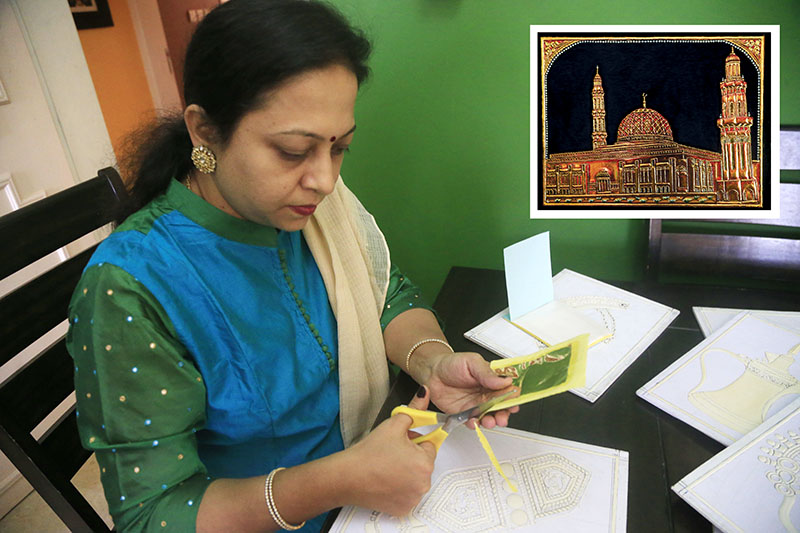
What does Tanjore painting, a traditional South Indian art form, have to do with Oman’s forts, mosques, and jewellery? A typical Tanjore painting contains one main figure, a deity. Kavitha Ramakrishna, a Muscat based Indian artist who is a practitioner of Tanjore paintings,has blended Oman’s culture and tradition with the ancient Indian art form. Kavitha’s paintings are famous for their elegance, brightness, and beauty. She also draws her creativity in oil painting even though she is very fond of Tanjore paintings. She is very much enthralled by the cultural harmony that exists between the Sultanate of Oman and India, which made her to blend Tanjore paintings with the culture of Oman. Almost a decade of her life in the country has given her insight into its people and culture.“I have dedicated a lot of my work with different themes like the Omani Khanjars, forts of Oman, Omani jewellery, the Holy Quran, and the Grand Mosque to the lovely and friendly people of Oman,” Kavitha said.
Some of her works have been presented to various Omani institutions as a gesture of goodwill and she has received many accolades from the Omani Government. The driving force behind her Omani works is Maitha bint Saif Al Mahrouqi, undersecretary, Ministry of Tourism, according to Kavitha.“I have exhibited close to 40 of my Tanjore art works at the Ministry of Tourism that portrayed Omani jewellery, the forts of Oman, the beautiful Khanjars (daggers), and artefacts,” she said.
Tanjore painting is an important form of classical South Indian painting, native to the town of Thanjavur in Tamil Nadu in India. From her childhood, Kavitha was fascinated by this traditional art and one of her relatives has introduced her to a ‘guru’ (teacher). “The surface richness, vivid colours, and compact composition of these paintings inspired and attracted me,” Kavitha said.
Tanjore painting is an art form that dates back to about 1600 A.D., a period where the Nayaks of Thanjavur encouraged this art. Tanjore paintings are created on solid wood planks referred to as “Palagai Padam (Palagai — wooden plank, Padam — picture).” Artists in Tanjore developed the art with material readily available in the local areas.Thereupon, this art has been developed by using precious and semi-precious stones for the jewellery cast in giving a three-dimensional perspective to the painting.The value of the painting increased with time as they started using pure gold leaf.
Speaking about the process she undergoes to complete a picture, Kavitha said, “the first step is the board preparation. In this, I cut the plywood to the required size like 8x12 or 12x15, then cut the piece of Cora cloth with slightly bigger measurement. Paste the cloth with the all-purpose flour paste and then apply the tamarind seed paste on top of the board. Once it is dry, I will smoothen the board with sand paper.”
The second step is drawing; draw or trace the design onto the canvas. For the third step we will make mug work and stone fixing. With the help of chalk powder and Arabic gum she makes a paste to do the mug work and also to fix the stones. The fourth step is the pasting of gold foils and the final step is to paint in the details. Kavitha takes one to two months to complete a painting.
She ardently popularises this ancient art form by holding free training sessions and she has trained many art lovers which she considers as one of her greatest achievements. “I have trained more than three hundred art lovers. I have also conducted a workshop in Indian School Muscat for both the students and teachers of the school,” Kavitha said. She has also introduced an e-learning platform for Tanjore paintings and has plans to increase the reach of the same by associating it with the Art, Culture, and Language Department of the Government of India. Avid learners, who are interested in knowing more about the Indian art, can log on to her website: kavithavedanthi.com or contact her on kavithakrishna21@ gmail.com The aim is to preserve the divine art and pass the knowledge to the future generations.
Kavitha has also exhibited her creativity twice at the Indian Embassy in Oman.
“I was also honoured to exhibit my works twice at the Indian Embassy, once during the period of the former ambassador Anil Wadhwa and on January 26 of this year on the occasion of the 67th Republic day of India,” Kavitha said. Kavitha is not that interested to do business with her creativity but likes to offer her works to the people of Oman whom she owes a lot for her success. She has also authored a book in Kannada language (spoken in the Indian state of Karnataka) about Oman called Na Kanda Muscat. Kavitha has captured the distinctive character of Oman through her writings.
“Having lived in Oman for 10 years, I feel a sense of belonging and respect for the people, the culture and the heritage of this country. This made me to write a book on Muscat, where I have tried to capture the distinctive character of this unique country,” she said.
“Apart from capturing the landscape of the country in its entire splendour, the book also dwells upon its wonderful people and the maker of this country, our beloved His Majesty Sultan Qaboos bin Said,” she added.
Currently, Kavitha plans to complete some more paintings before the 46th National Day of Oman and wishes to dedicate them to the people of Oman. For her, patience and passion can lead to perfection and these are the keywords as an advice to the aspiring kids who love to pursue their career in the arts.
—[email protected]